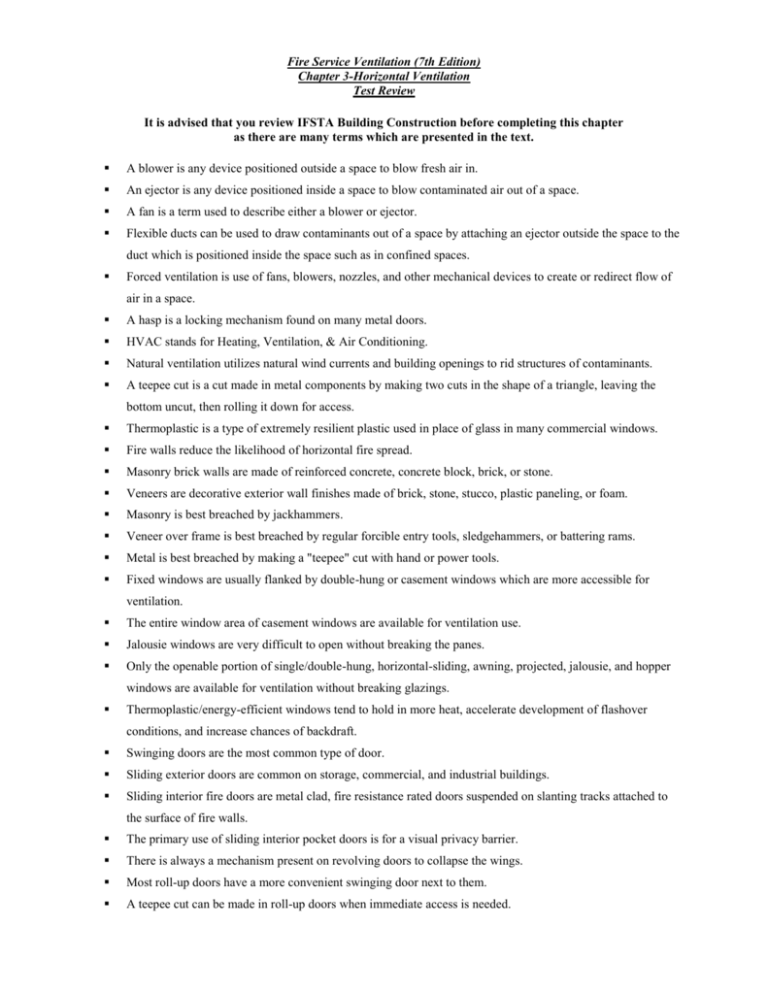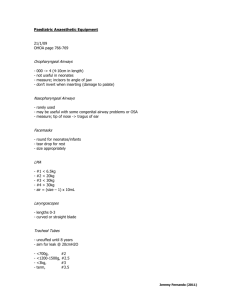Fire Service Ventilation (7th Edition)
advertisement

Fire Service Ventilation (7th Edition) Chapter 3-Horizontal Ventilation Test Review It is advised that you review IFSTA Building Construction before completing this chapter as there are many terms which are presented in the text. A blower is any device positioned outside a space to blow fresh air in. An ejector is any device positioned inside a space to blow contaminated air out of a space. A fan is a term used to describe either a blower or ejector. Flexible ducts can be used to draw contaminants out of a space by attaching an ejector outside the space to the duct which is positioned inside the space such as in confined spaces. Forced ventilation is use of fans, blowers, nozzles, and other mechanical devices to create or redirect flow of air in a space. A hasp is a locking mechanism found on many metal doors. HVAC stands for Heating, Ventilation, & Air Conditioning. Natural ventilation utilizes natural wind currents and building openings to rid structures of contaminants. A teepee cut is a cut made in metal components by making two cuts in the shape of a triangle, leaving the bottom uncut, then rolling it down for access. Thermoplastic is a type of extremely resilient plastic used in place of glass in many commercial windows. Fire walls reduce the likelihood of horizontal fire spread. Masonry brick walls are made of reinforced concrete, concrete block, brick, or stone. Veneers are decorative exterior wall finishes made of brick, stone, stucco, plastic paneling, or foam. Masonry is best breached by jackhammers. Veneer over frame is best breached by regular forcible entry tools, sledgehammers, or battering rams. Metal is best breached by making a "teepee" cut with hand or power tools. Fixed windows are usually flanked by double-hung or casement windows which are more accessible for ventilation. The entire window area of casement windows are available for ventilation use. Jalousie windows are very difficult to open without breaking the panes. Only the openable portion of single/double-hung, horizontal-sliding, awning, projected, jalousie, and hopper windows are available for ventilation without breaking glazings. Thermoplastic/energy-efficient windows tend to hold in more heat, accelerate development of flashover conditions, and increase chances of backdraft. Swinging doors are the most common type of door. Sliding exterior doors are common on storage, commercial, and industrial buildings. Sliding interior fire doors are metal clad, fire resistance rated doors suspended on slanting tracks attached to the surface of fire walls. The primary use of sliding interior pocket doors is for a visual privacy barrier. There is always a mechanism present on revolving doors to collapse the wings. Most roll-up doors have a more convenient swinging door next to them. A teepee cut can be made in roll-up doors when immediate access is needed. Air flow through a structure can be interrupted by partitions, the arrangement of rooms, and stacks of highpiled storage. It is a good practice to close doors once a room has been searched. Ejectors or fog streams used for ventilation are put on the leeward side of buildings. Blowers are placed on the windward side of buildings. Top windows on the leeward side of a building should be opened first to allow heated gases to escape. Screens, curtains, and blinds will hinder air circulation. In the absence of a blower, windward side windows should not be opened until initial knockdown of the fire. When breaking a window, use the flat side of an axe, with the handle held higher than the blade. Circular saws with carbide-tipped, medium tooth blades, can be used to open thermoplastic glazings. Striking a thermoplastic glazing with a sledgehammer will not break the pane, however, it will bow the pane enough to slip it out of the frame in most cases. Scoring a thermoplastic pane with an "X" will usually allow the pane to break along the scoring when struck. Thermoplastic glazings can be frozen with a CO2 extinguisher, then struck in the middle with a pick head axe. If a thermoplastic pane has been heated by fire, striking methods may not be successful. Smoke ejectors must have explosion-proof motors. When using a smoke ejector, the open area around the ejectors should be sealed to prevent churning. The cone of air from a blower should cover the entire opening. Hydraulic ventilation may increase water damage and drain the available water supply. Hydraulic ventilation is limited to negative pressure ventilation. Operations involving hydraulic ventilation must be interrupted each time the operator runs out of breathing air.







